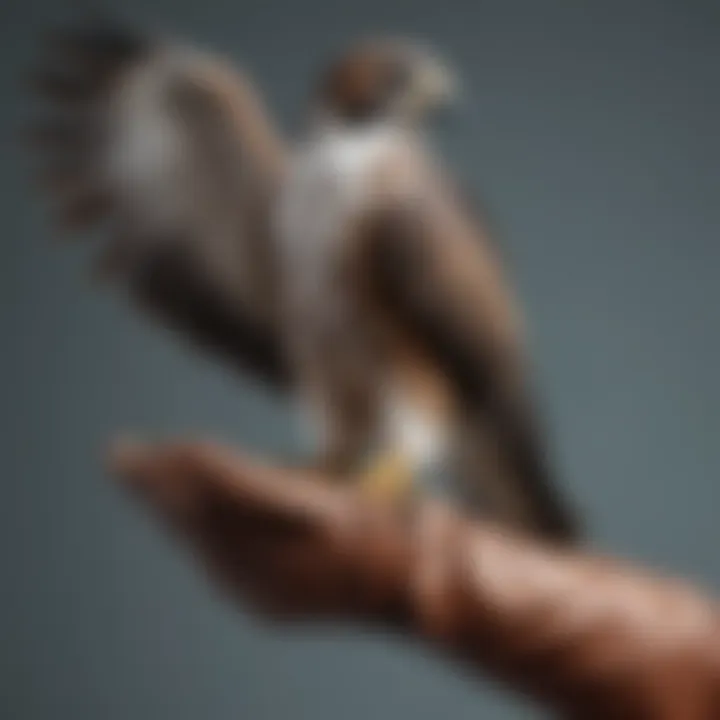Unraveling the Intricacies of Falconry Costs: A Thorough Guide


Understanding the Costs of Falconry: A Detailed Analysis
Falconry, an ancient art form that involves using trained birds of prey for hunting, is a practice that requires meticulous financial consideration. From the initial investments required to set up a suitable environment for the birds to the ongoing expenses for their care and maintenance, engaging in falconry demands a deep understanding of the financial landscape involved.
Initial Investments
The journey into falconry begins with substantial upfront costs. Prospective falconers must allocate funds for acquiring necessary equipment such as falconry hoods, jesses, and anklets. Moreover, constructing a safe and spacious mews, a place where the birds are housed, demands considerable financial resources. These initial investments form the foundation for a successful and sustainable falconry practice.
Ongoing Upkeep Expenses
Beyond the initial setup, falconry entails continuous expenses for the welfare of the birds. High-quality food, veterinary care, and essential supplies like gloves and perches contribute to the recurring costs of falconry. Additionally, training sessions and falconry courses are crucial components that require financial commitment to ensure the well-being and skill advancement of the birds.
Financial Considerations
Delving deeper into the financial aspects, aspiring falconers must evaluate the long-term expenditure involved in falconry. Factoring in variables such as unexpected medical expenses for the birds, permits, and licenses, as well as potential repair or replacement costs for equipment, is essential for financial planning and sustainability in the practice of falconry.
In summary, embarking on the journey of falconry is not only a profound cultural and personal experience but also a significant financial undertaking that demands careful consideration and planning to ensure the well-being of the birds and the longevity of the practice.
Introduction to Falconry
Falconry, an ancient art form dating back centuries, holds a captivating allure for enthusiasts seeking a deep connection with nature. This article provides a detailed analysis of the financial aspects associated with falconry, shedding light on the initial investments, ongoing expenses, and economic considerations essential for aspiring falconers.


Historical Overview of Falconry
The historical backdrop of falconry traces a rich tapestry through time, reflecting the intimate relationship between humans and majestic birds of prey. From its origins in ancient Mesopotamia to its prominence in medieval Europe, falconry earned a revered status as a symbol of nobility and power. The intricate training techniques developed over generations underscore the deep cultural significance attributed to this art form, highlighting the dedication and skill required to master the nuances of falconry.
Initial Falconry Costs
In delving into the financial realms of falconry, understanding the Initial Falconry Costs holds paramount importance. This section serves as the foundational pillar for aspiring falconers, elucidating the crucial aspects that dictate the commencement expenses involved in embracing this ancient art form. Initial Falconry Costs encompass various elements that set the tone for a falconer's journey, ranging from the acquisition of falcons to the necessary training and essential equipment expenses.
Acquisition of Falcons
The Acquisition of Falcons stands as a pivotal step in the initiation of falconry endeavors. Procuring these majestic birds involves intricate processes, including sourcing reputable breeders, assessing the health and quality of the falcons, and adhering to legal regulations governing their acquisition. It necessitates a diligent approach to ensure the selection of suitable falcons complementing the falconer's skill level and specific falconry pursuits.
Training Expenses
Navigating the realm of falconry demands a profound understanding of the avian companions under one's care. Training Expenses constitute a significant portion of the initial costs, encompassing expenses related to expert guidance, specialized training facilities, and relevant training materials. These expenses reflect the dedication and commitment required to cultivate a harmonious bond between the falconer and their falcon, laying the groundwork for successful falconry practices.
Equipment Costs
Equipping oneself with the essential tools and gear is indispensable in the world of falconry. Equipment Costs encapsulate the financial outlay associated with acquiring falconry essentials such as falconry hoods, jesses, perches, and telemetry systems. Each piece of equipment plays a crucial role in facilitating smooth falconry sessions, underscoring the significance of investing in quality gear to ensure the well-being and performance of both the falcon and the falconer.
Ongoing Financial Commitments
In the realm of falconry, Ongoing Financial Commitments hold immense significance as they encapsulate the continual expenses essential for the maintenance and well-being of these majestic birds. Falconry enthusiasts must meticulously plan and allocate resources to cover various aspects that contribute to the overall costs, ensuring the falcons receive optimal care. These commitments encompass not only the financial outlay but also the dedication and responsibility required to sustain a harmonious environment for the birds to thrive. Understanding the nuances of Ongoing Financial Commitments is imperative for falconers to nurture a strong bond with their avian companions while upholding ethical standards within the falconry community.


Maintenance and Care
When delving into the intricacies of Maintenance and Care in falconry, one unravels a tapestry of duties essential for ensuring the well-being and optimal health of falcons. Maintenance involves daily tasks such as cleaning equipment, feeding the birds, and monitoring their condition, while Care encompasses broader aspects like providing adequate nutrition, maintaining hygiene, and ensuring the falcons exhibit no signs of distress. Falconers need to devote considerable time and effort to these aspects, fostering a deep understanding of the birds' behavior and needs to cultivate a nurturing environment that promotes their physical and mental well-being.
Veterinary Expenses
The domain of Veterinary Expenses in falconry demands careful consideration, as avian healthcare necessitates specialized knowledge and skills to address potential medical issues promptly and effectively. Falconers must factor in routine veterinary check-ups, vaccinations, and emergency care provisions to safeguard the health of their avian companions. Collaborating with experienced avian veterinarians is crucial to diagnose and treat ailments, thereby ensuring the longevity and quality of life for falcons under their care. By prioritizing Veterinary Expenses, falconers exhibit their commitment to providing the highest standard of medical care for their feathered partners.
Housing and Facilities
Housing and Facilities constitute fundamental pillars of falconry, encompassing the construction and maintenance of aviaries, mews, and other structures that serve as shelters for the falcons. These facilities should offer ample space, protection from environmental elements, and a conducive atmosphere that aligns with the birds' natural habitat. Falconers must invest in sturdy infrastructure that ensures the security and comfort of their birds, adhering to best practices in aviary design and maintenance. By prioritizing the development of robust Housing and Facilities, falconers create a safe haven where their falcons can flourish and exhibit their innate behaviors in a stress-free environment.
Variable Factors Impacting Falconry Costs
In the realm of falconry finances, understanding the variable factors impacting costs is crucial. These factors play a pivotal role in determining the overall financial outlay associated with practicing this ancient art form. By examining these elements, individuals are able to make informed decisions regarding their financial commitments within the realm of falconry. Factors such as geographic location, availability of resources, and economic conditions can greatly influence the costs involved, making it imperative for aspiring falconers to consider these variables.
Geographic Location
One of the significant components affecting falconry costs is the geographic location where the falconer resides or intends to practice this art. The environment and climate of a region can directly impact the expenses associated with maintaining falcons. For instance, regions with extreme temperatures may require additional investments in specialized equipment to ensure the well-being of the birds. Moreover, the availability of suitable hunting grounds and training areas can vary depending on the location, affecting both initial costs and ongoing expenses.
Furthermore, veterinary services and supplies may differ in price based on the region, leading to potential fluctuations in the overall cost of falconry upkeep. Additionally, government regulations and permits related to falconry can vary by location, potentially influencing the administrative expenses associated with practicing this art form. Hence, considering the geographic location is vital when estimating the financial commitments involved in falconry, as it adds a layer of complexity and variability to the overall expenses.


Economic Considerations for Falconers
In the realm of falconry, economic considerations hold a paramount position, shaping the entire landscape of this ancient practice. Falconry enthusiasts, whether novice or seasoned, are bound to deliberate extensively on the financial aspects that come hand in hand with nurturing and training these magnificent birds of prey. The economic dimension of falconry extends beyond mere hobby expenditure, evolving into a realm where investments must be carefully weighed against the anticipated returns both in terms of personal satisfaction and potentially even financial gains.
Cost-Benefit Analysis
Conducting a thorough cost-benefit analysis is an indispensable aspect for any individual contemplating delving into the world of falconry. This strategic evaluation involves a meticulous breakdown of the expenses involved in acquiring, maintaining, and caring for falcons juxtaposed against the perceived benefits and rewards of the practice. By meticulously dissecting each cost component and juxtaposing it against the expected advantages, falconers can make informed decisions regarding the financial viability and feasibility of their falconry pursuits. Through this analytical approach, falconers can ascertain whether the personal and professional fulfillment derived from falconry justifies the financial investments required.
Revenue Generation Potential
Delving into the realm of falconry unveils a spectrum of potential avenues through which revenue generation can be facilitated. Falconers with a keen eye for exploring the economic facets of their passion can leverage opportunities such as falconry displays, educational workshops, and even pest control services to generate income. Moreover, participation in falconry competitions and events can not only provide a platform to showcase skill and expertise but also serve as a lucrative avenue for prize winnings and monetary rewards. By strategically honing in on these revenue streams, falconers can transform their passion into a sustainable source of income, establishing a harmonious balance between financial prudence and avian ardor.
Conclusion
In this expansive journey through the intricate world of falconry costs, we have unearthed a vast array of financial considerations that hold immense significance for any aspiring falconer. The topic of Conclusion within this article serves as the crowning jewel, tying together the various strands of initial investments, ongoing expenses, and economic factors that underpin the art of falconry.
This final section encapsulates the essence of prudent financial planning in the realm of falconry, emphasizing the need for a meticulous approach to budgeting and resource management. By delving into the intricacies of Conclusion, readers gain a comprehensive insight into the holistic picture of costs associated with nurturing a bond with these majestic birds.
Moreover, the Conclusion segment offers valuable takeaways on strategies to optimize financial resources, the long-term benefits of sound financial decisions in falconry pursuits, and considerations that extend beyond mere monetary outlays. It underlines the necessity for prospective falconers to not only understand the immediate costs involved but also to foresee and plan for the economic responsibilities that come with this time-honored practice.
Summary of Key Cost Components
The Summary of Key Cost Components within the overarching theme of falconry costs plays a pivotal role in distilling the plethora of financial obligations entwined with this ancient art form. By examining the essential elements that contribute to the financial landscape of falconry, readers gain a nuanced understanding of the core expenses inherent in falconry pursuits.
This section meticulously breaks down the key cost components, shedding light on the acquisition of falcons, training expenses, equipment costs, maintenance and care, veterinary expenses, and requirements for housing and facilities. By providing detailed insights into each cost component, readers are equipped with a well-rounded perspective on the financial investments necessary to embark on a falconry journey.
Furthermore, the Summary of Key Cost Components delves into the intricacies of variable factors that can impact falconry costs, such as geographic location. By acknowledging these factors, aspiring falconers can better formulate a comprehensive financial plan and navigate the fluctuating economic considerations that come with engaging in falconry.
Overall, this section acts as a comprehensive guide for individuals interested in the financial facets of falconry, offering a detailed roadmap to navigate the complex terrain of monetary commitments and cost considerations in the pursuit of this ancient and prestigious art.





